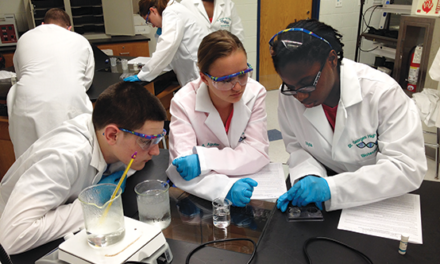Students may plagiarize for many reasons, ranging from laziness to sloppiness to a lack of understanding about the reason for citations, but teachers can employ a series of strategies to prevent problems while also teaching students good scholarly practices.
#10. They are lazy.
While every teacher has entertaining stories about students who hand in papers that still have other students’ names on them, these cases are relatively rare. Most students do not plagiarize intentionally. In fact, in a study of students at the college where I teach, many mentioned that they were worried about unintentionally plagiarizing. Sam said she was in a “panic about plagiarism.” Aubrey, who had notebooks full of her creative writing, believed she was not good at research papers because, “I was really scared about plagiarizing.” However, for students who are looking for the easy way out of your assignment, the best way to keep them from plagiarizing is to make doing so too much work.
What you can do:
- Let students know the consequences of plagiarizing. Students are less likely to plagiarize deliberately if they perceive the cost of getting caught as too high. Make sure to have a clear statement in your syllabus, and let students know that you use Turn-It-In, Google, or some other method of checking their sources.
- Make it so hard to plagiarize that they might just as well write the paper. For example, you can require them to document their writing process by handing in a paper proposal, an outline, an annotated bibliography, multiple drafts, a copy of one or more of their sources, and/or a reflection piece on their writing. Requesting these things does not mean you necessarily have a whole lot more work to do. You can use a peer response exercise or in-class work for quick reviews of many of these items. If you ask for multiple drafts, only check for a few things on each draft (for example, just for main idea and basic structure on the first draft or just for citation format on a second draft). Besides preventing plagiarism, collecting these documents can help you assess student learning and, when necessary, intervene before the bitter end.
- Make it hard to plagiarize by designing assignments around specific, focused questions or issues. Avoid general topics like character in Hemingway. There are so many papers on the internet on such topics that the temptation may be too great.
- Students are less likely to plagiarize if they feel connected to a school through bonding with fellow students and teachers, through small classes, and through fresh assignments thatrequire original thought rather than the rehashing of old debates (Ashworth & Bannister, 1997).
#9. They panic.
Some students will deliberately plagiarize when they feel themselves backed into a corner in a high-pressure situation with a low risk of being caught. Often, this behavior is a result of poor time management and organization skills. It frequently happens when students are new to the kind of work they are being asked to do because they are less likely to know how to organize themselves, may have unrealistic expectations about what they can do, and are less invested in the process. As a result, you might expect this behavior not only in incoming students but also when students are first asked to step up to a new level of work such as their first extended research project.
What you can do:
- Help students learn how to pace themselves and organize their work, especially if the task you have given them is complex, and they are novices. This can be done by warning them of common process problems at the start, by assigning intermediate steps, by conducting an ongoing discussion of their process (online discussion groups are good for this and do not take class time), and by modeling your process.
- Explicitly discuss with students why the assignment is important in the context of the class and of their learning. Tell them what transferable skills and knowledge they will gain from doing this assignment.
- Finally, as in #10, make the risks and consequences of being caught clear.
#8. They lack confidence.
Even students who are confident about their ideas may be tempted to borrow an author’s words because the author “says it better than I can.” Students may not be familiar with the jargon that’s used in some academic areas that are new to them. They may feel awkward about trying to incorporate those words and phrases into their writing.
While Sophia did not plagiarize, she exemplifies this thinking when she explains why she used only direct quotes from authors to speak for her: “So many times, I’ll read things and go, ‘oh, that sounds really, that’s just how I feel.’ . . . you can’t plagiarize, as we know, so I’m just like, ‘oh somebody had said that,’ . . . I hate to say it’s easier, but it’s more cautious to do that.” Sophia repeated the words of academics that best matched her feelings, but in doing so she did not give herself a chance to develop her own ideas or her voice.
What you can do:
- Help students see how they already have expertise in many areas, such as movie reviews, their favorite music, sports, or leisure activity, and equate learning academic jargon with the learning they have already done to master these other topics.
- Have students write down their ideas before, during, and after research. The student who has put down their guesses about what they will find and who has written a response immediately after reading a source will be less likely to act as a passive collector of information.
#7. They think they’re supposed to reproduce what the experts have said.
Students may be under the impression that scholarly publications are just repositories of facts, places they can go to find the truth of the matter, just as they might go to a dictionary to look up a definition or the correct spelling of a word. Thus, they may assume there’s no need to cite ideas and arguments from research sources, any more than one needs to cite Webster’s after looking up how to spell a word (Lipson & Reindl, 2003).
Similarly, many students think learning is a passive process, whereby they’re supposed to let other people fill their heads with knowledge, like vessels being filled with water. Thus, they may assume that the point of doing research for a paper is to collect ideas, quotes, and evidence from experts. Then, to show what they’ve learned, they will reproduce it in the form of quotations, summaries, and paraphrases, perhaps knitting together those pieces with some brief transitions. These are students who, after you explain a plagiarism policy, will say, “So you want me to cite every sentence?” They are most likely to plagiarize by failing to cite paraphrases and summaries, although they do tend to cite direct quotes (Lipson & Reindl, 2003; Ashworth & Bannister, 1997). For example, one of my college students — who counseled teenage mothers and had been one herself — turned in a paper on teenage pregnancy that was almost entirely pasted together from online sources. When asked why she didn’t use her own experience or express her well-developed opinions, she replied that she thought she could only use the words of “experts.”
What you can do:
- Require students to generate a hypothesis before they begin researching. Situate research as the attempt to test and refine their hypothesis.
- Show students examples of student papers with uncited summaries and paraphrases and require them to identify and correct the problem.
- When a paper is handed in, give it a quick scan. If the student only cited direct quotes, he or she may be neglecting summaries and paraphrases.
#6. They have difficulty integrating source material into their own exposition or argument.
It’s not easy to write an effective summary, paraphrase without plagiarizing, and weave quotations into one’s own text. This is particularly true if students are simultaneously figuring out what they think and learning how to formulate their argument according to the conventions of a particular field. Like the students in #7, these students are likely to summarize or paraphrase without appropriately citing their sources.
What you can do:
- Teach students to put their source material out of sight when they write their summaries so they are not tempted by the lovely words of the author.
- Discourage paraphrase as much as possible since it can very easily lead to the bleeding of the author’s words and phrases into the student’s language.
- Look for papers in which the citations only come at the end of paragraphs. This is often a sign that the student thinks the citation in the last sentence covers all borrowing from the source anywhere in the paragraph.
#5. They do not understand why people make such a fuss about sources.
Some students feel that their experience is enough to support their claims. Others see collecting sources as an add-on chore. These students will ask, “If the source says the same thing I’m saying, do I have to cite it?” or “Do I need to cite my own ideas if I find that someone else has thought them?” These students do not see themselves as members of a scholarly community that is collectively building knowledge but, rather, as islands of self-contained knowledge or as outsiders who are merely trying to get through this ordeal (Ashworth & Bannister, 1997). To them, the conventions about citing sources may seem overly fussy and secondary to the process of learning (Ashworth & Bannister, 1997).
Their annoyance with these conventions is heightened when they discover that citation rules can sometimes be contradictory or incomplete. In addition, some of their teachers may not require that they cite sources at all, while others haven’t kept up with recent changes in citation styles. As a result, the rules of citation may seem to change from class to class.
What you can do:
- Explicitly discuss with students the goals of their research.
- Stress their membership in a community of scholars to which they are also contributing as well as borrowing knowledge (Ashworth & Bannister, 1997).
- Acknowledge up front that citation styles, especially for internet sources, are in flux.
- Work with other teachers in your school (or better yet, your district) to develop citation rules that govern all student work, and use those rules consistently from teacher to teacher and subject to subject.
- Help students learn how to extrapolate from the examples presented in style manuals to craft citations for unusual sources.
#4. They are sloppy.
Even professional writers and researchers can be sloppy in their note taking, leaving them confused about what they wrote themselves and what they copied down from a source. (For example, the well-known historian Doris Kearns Goodwin was accused of plagiarizing portions of a few of her books; she claims that she did so inadvertently by relying on notes that she thought were her own words.) This confusion can get muddled not just on paper but also in writers’ minds. For example, one of my students told me that when she is really focused on a project, her brain will become like a tape recorder — a week or two after reading sources, she’ll remember words verbatim, but she won’t remember whose words they were. She is not alone. A study of English university students reported that “It was considered [by the students] highly feasible for a phrase or sentence from a text to lodge in one’s subconscious and be reproduced word-for-word in an assignment” (Ashworth & Bannister, 1997).
What you can do:
- Teach students strategies for organizing their notes.
- Insist that students include citations in all drafts. Students often will say they will put the citations in later, but then they forget where they go. Tell them they can work on formatting citations in later drafts, but all drafts must be cited.
#3. They do not understand that they need to cite facts, figures, and ideas, not just quotations.
These students are not trying to slip something past you. If they were, they wouldn’t have gone to all the effort of including citations for every quotation they’ve included in their papers. Very often, students are simply confused about which kinds of information need to be cited, or they assume that a citation placed at the end of a paragraph is sufficient to cover all of the sources they relied on in earlier sentences.
What you can do:
- Make sure every source in the references corresponds to a citation in the text. If there are more sources in the references than in the text, ask where the source appears in the text.
- See also the suggestions for # 6 and #7 above.
#2. They are learning.
Some scholars of writing composition argue that students who abuse paraphrasing by simply inverting word order or changing word forms are just trying to digest new material. Such “patchwriting,” they say, is part of a long tradition of learning to write by copying more expert writers, imitating them as a way to begin processing and absorbing new content and skills (Howard, 1995). Consider, for example, Benjamin Franklin’s (1788) method of teaching himself to write: “I thought the writing [in The Spectator] excellent, and wished, if possible, to imitate it. With this view I took some of the papers, and, making short hints of the sentiment in each sentence, laid them by a few days, and then, without looking at the book, try’d to compleat the papers again, by expressing each hinted sentiment at length, and as fully as it had been expressed before, in any suitable words that should come to hand.”
What you can do:
- Considerpatchwrittenpapers as early drafts.
- Discuss with students the need to digest and analyze material in more sophisticated ways.
- Work with them on summarizing rather than paraphrasing.
AND THE #1 REASON STUDENTS PLAGIARIZE IS . . .
#1. They are used to a collaborative model of knowledge production.
For students who have grown up with sampled music and video mashups, who come from certain cultural backgrounds, or who’ve experienced certain kinds of collaborative learning, it can be confusing to be told that they are supposed to distinguish their own thoughts and ideas from those of their friends and family members (Price, 2002). Where does one draw the line between the two? Does one need to acknowledge parental influence on the development of one’s thinking? What about a peer’s suggestion to add an example to a paper? And what about clergy who repeat phrases and ideas that many others have used before them? Are they plagiarizing their sermons, or are they taking advantage of a shared resource?
Most composition scholars writing on plagiarism will point out that it is largely a modern idea, which arose with romantic individualism and capitalist notions of private property (Bowden, 1996; Howard, 1995; Woodmansee & Jaszi, 1995). In recent years, research into the socially constructed nature of knowledge has profoundly challenged the view of the author as a singular, discrete creative force, able to come up with “original” words and ideas (Bowden, 1996; Howard, 1995; Woodmansee & Jaszi, 1995). As Bowden (1996) puts it, “Plagiarism is perhaps one of the foremost and richest of postmodern dilemmas.”
What you can do:
- Discuss gray area cases with students.
- Discuss and ensure that students understand the reasons for citing sources.
- Foreground and discuss with students the context-specific nature of what does and does not count as plagiarism (Price, 2002).
References
Ashworth, P. & Bannister, P. (1997). Guilty in whose eyes? University students’ perceptions of cheating and plagiarism in academic work and assessment. Studies in Higher Education, 22, 187-204.
Bowden, D. (1996). Coming to terms: Plagiarism. English Journal, 85 (4), 82-85.
Franklin, B. (1788). The autobiography of Benjamin Franklin. https://wwnorton.com/college/history/america-essential-learning/docs/BFranklin-Autobiography-1788.pdf
Howard, R.M. (1995). Plagiarisms, authorships, and the academic death penalty. College English, 57, 788-807.
Lipson, A. & Reindl, S.M. (2003, July-August). The responsible plagiarist: Understanding students who misuse sources. About Campus, 7-14.
Price, M. (2002). Beyond ‘gotcha’: Situating plagiarism in policy and pedagogy. College Composition and Communication, 54 (1), 88-116.
Woodmansee, M. & Jaszi, P. (1995). The law of texts: Copyright in the academy. College English, 57, 769-788.
Citation: Cleary, M.N. (2017). Top 10 reasons students plagiarize & what teachers can do about it (with apologies to David Letterman). Phi Delta Kappan 99 (4), 66-71.

ABOUT THE AUTHOR

Michelle Navarre Cleary
MICHELLE NAVARRE CLEARY is an associate professor in the School for New Learning, DePaul University, Chicago, Ill.










